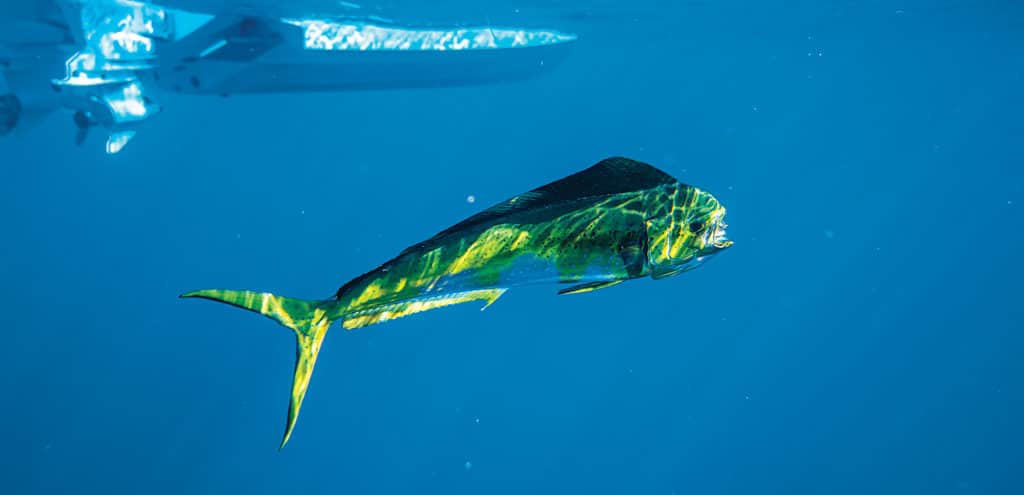
Lee Williams and I were drifting Lucanus jigs over a wreck 30 miles off Virginia Beach when Lee’s line went slack. “I just broke off,” he cursed. As he cranked in his line, I spotted a gold-and-silver dolphin doing a back flip 30 feet behind the boat. The fish had his jig in its mouth. On the next jump, the dolphin threw the jig at us and splashed off into the distance. We jumped into action. In minutes we had the jigging gear stowed and a spread of ballyhoo trolling behind the boat. On the first pass, we loaded the lines with dolphin.
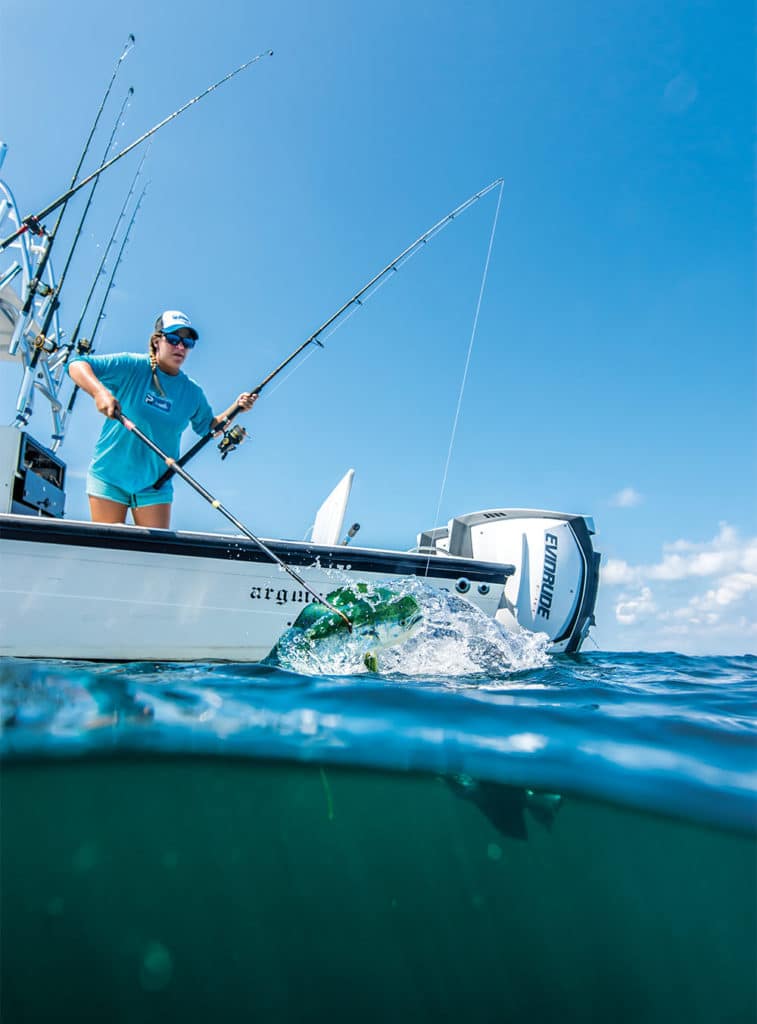
Yellow Brick Road
Whether you call them dolphin, dorado or mahimahi, these fish love warm water and structure. The best place to find perfect conditions is off Hatteras Island where the Gulf Stream collides with the Labrador Current and miles of floating sargassum gathers in long lines that local anglers call the yellow brick road.
During the summer, Capt. Olan West spends nearly every day fishing the Land of Oz.
West starts the day looking at a satellite image of water temperature for the intersection of the warm Gulf Stream and the 100-fathom drop.
He heads toward the crossroads, looking for current breaks, a temperature change, floating sea junk or a weed line.
Once he finds the grass, he slows the boat to 6 knots and puts out a spread of small ballyhoo. Dolphin often attack in packs and then take off in every direction. West avoids chaos by limiting the spread to six lines. He explains, “Trolling fewer lines means less chance of tangles.”
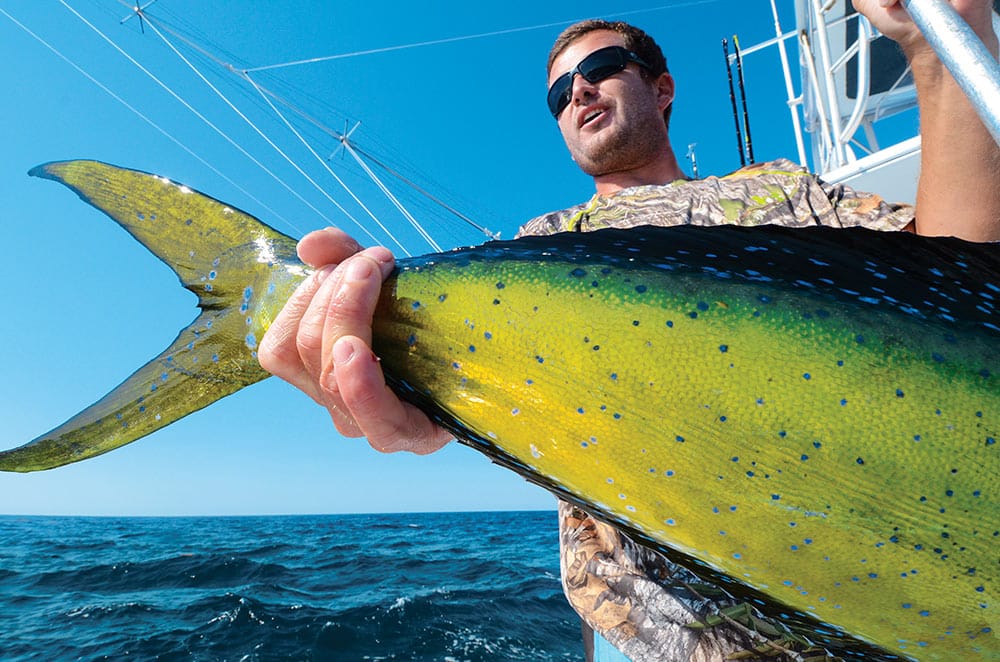
When the dolphin attack, West keeps trolling until every line is tight with a fish, keeping the boat slowly moving down the weed line. “Never stop,” he insists. “The school is always moving.”
When the school shows up behind the boat, West switches out his trolling gear for bailing rods. During the transition, he keeps a hooked fish in the water to hold the school nearby.
Using a medium-heavy conventional rod, each angler drops a 2-ounce sinker and 5/0 hook baited with a chunk of false albacore into the school. To keep the fish fired up, West’s mate chums with handfuls of bait.
Orchestrating the action in the pit holds the school behind the boat and keeps the dolphin biting. The mate boats each fish, rebaits the hook and sends it back out. West says, “If there isn’t a bait in the water, the fish quickly lose interest.”
When the bite tapers off, West puts the boat in gear and trolls the bait chunks along the weed line. If he doesn’t pick up the school after a few minutes, he will switch back to ballyhoo and go on the hunt again.
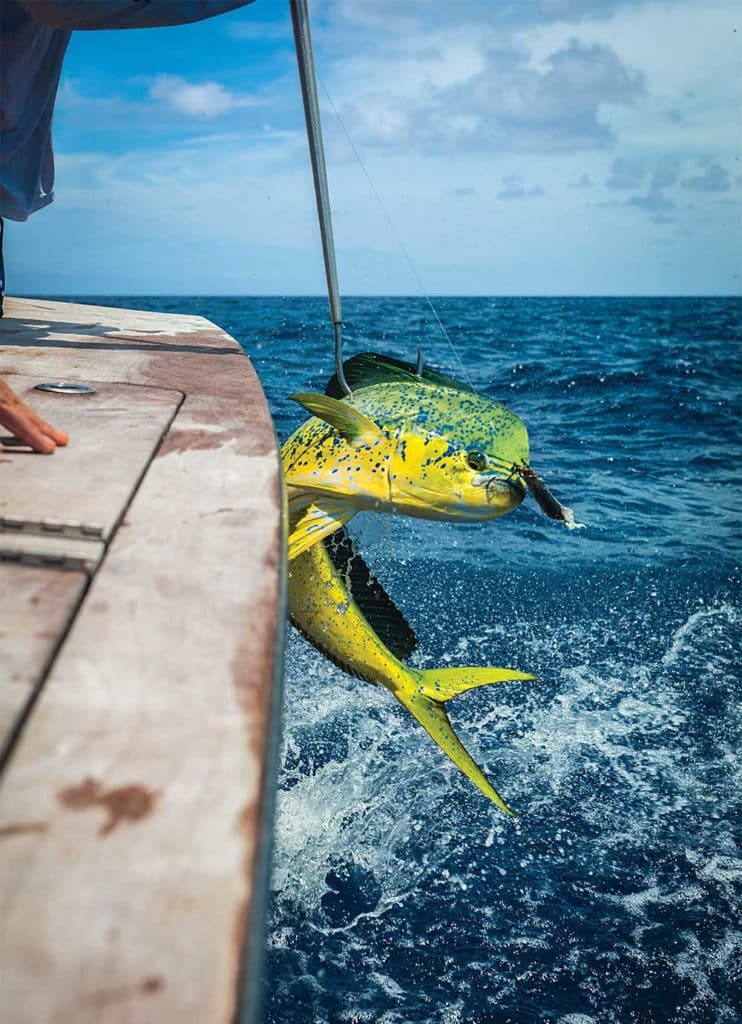
Run and Gun
Down in the Florida Keys, dolphin are a mainstay of early summer fishing, and Capt. Beau Woods is on them. “I would classify myself as a run-and-gun fisherman,” Woods says. He prefers covering water, looking for signs of dolphin instead of trolling and hoping for a bite.
Woods looks for mats of floating grass and sea junk holding the fish. Flying fish are a good sign, but Woods is careful to read their behavior. “If I spook fliers with the boat, it’s not necessarily a sign of dolphin,” he says. Instead, he looks for fliers flushing in the distance.
Another key to run-and-gun success is identifying birds. “Frigate birds are the best sign,” he says. When a frigate bird flies high, searching the water, he pulls out binoculars and follows the bird’s line of sight. “Depending on the angle of the sun, the bird could be looking at fish up to a quarter mile away,” he says.
Once Woods finds the dolphin, he throws a topwater popper or bucktail. Since the lures are always ready to fish, he saves time baiting hooks.
When the dolphin lose interest in his artificials, Woods hands each angler a rod baited with a live bait. He keeps two rods rigged for every angler. Instead of pausing to unhook the fish or retie a hook, he hands the angler another rod to keep the action steady.
When the fish get finicky, he switches tactics and deploys the trolling spread.
Woods pulls three lines, each armed with a trolling lure. He swears by a straight-tracking, tuna-style bullethead lure set 30 feet behind the boat so it pops out of the water every few seconds, and another identical lure set far enough back so it tracks beneath the surface and stays submerged at trolling speed.
Woods rigs lures to swim with the hook sticking up. “I can run through weeds, and 80 percent of the time I won’t get snagged,” he says.
Fishing off the Florida Keys, Woods has hundreds of square miles to cover in search of dolphin. “Knowing what to look for makes the best use of time,” he says.
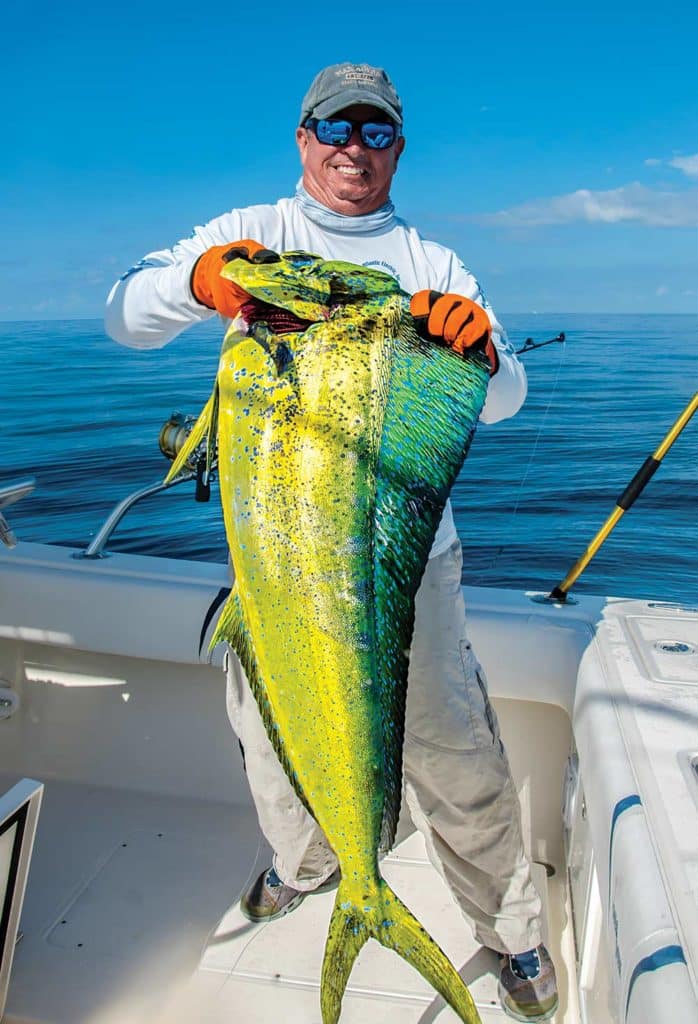
Flying High
Dolphin arrive off New England on eddies spinning off the Gulf Stream. From summer through early fall, Rhode Island-based Capt. Kyle Oneppo looks for dolphin on lobster pot buoys, called high fliers.
He starts the day trolling for marlin or tuna but keeps an eye open for structure. “I note every high flier I see on my chart plotter,” he says.
The best buoys hold a thick layer of seaweed, indicating they’ve been in the water long enough to attract life. If a buoy line isn’t holding fish, he quickly moves to another. He explains, “Each line is about 1,000 yards from the next, so I keep searching until I find a good set.”
Read Next: Dual Strategies for Florida Dolphin in the Summer
When he finds a buoy holding dolphin, he throws out a handful of herring chum followed by a 6-inch RonZ jig. “The jig brings the fish to the surface,” he explains.
If the dolphin don’t respond to the jig, he switches to small chunks of squid or herring on an unweighted 3/0 hook and 30-pound fluoro leader. Dolphin can turn finicky. “I start with light leader and a small hook so I don’t take a chance of spooking the fish.
“The bite, when it comes, may only last a few minutes,” Oneppo says. Fishing at the northern end of the dolphin’s range, he must take advantage of every opportunity. “We try not to leave any fish in the water.”
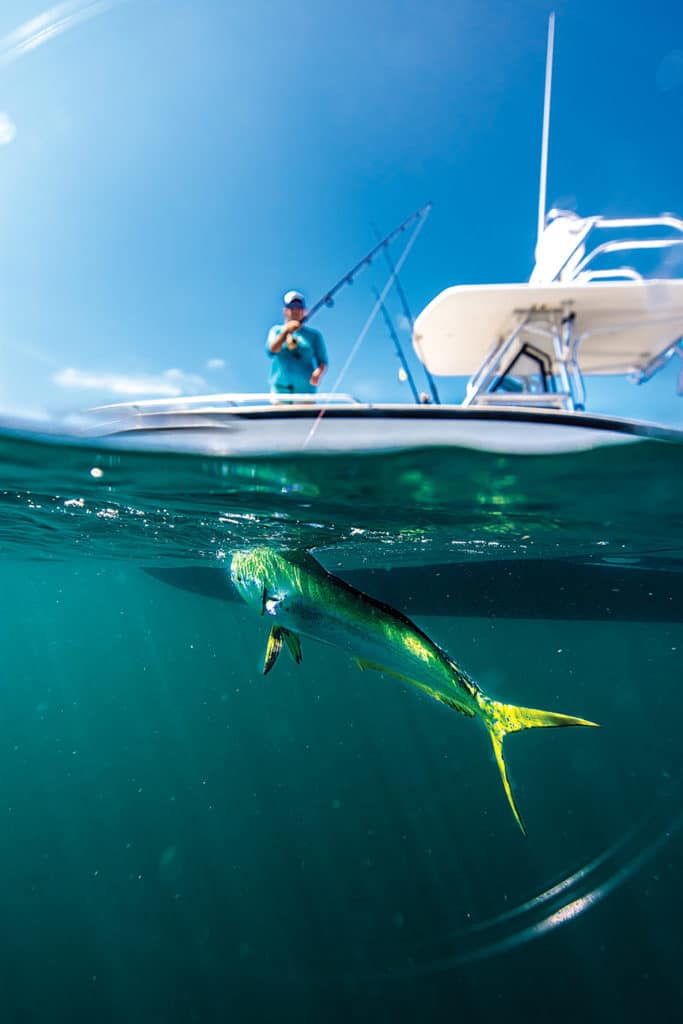
SWS Planner: East Coast Dolphin
What: Dolphin, aka dorado or mahi
When: Summer
Where: Northeast, mid-Atlantic, Southeast
Who:
Capt. Olan West West Wind
Oregon Inlet Fishing Center
outerbanksdeepseafishing.com
252-423-1162
Capt. Beau Woods
OO Charters
Cudjoe Key, Florida
fishdoubleocharters.com
305-294-3882
Capt. Kyle Oneppo
East Coast Charters
Narragansett, Rhode Island
eastcoastchartersri.com
401-533-3331
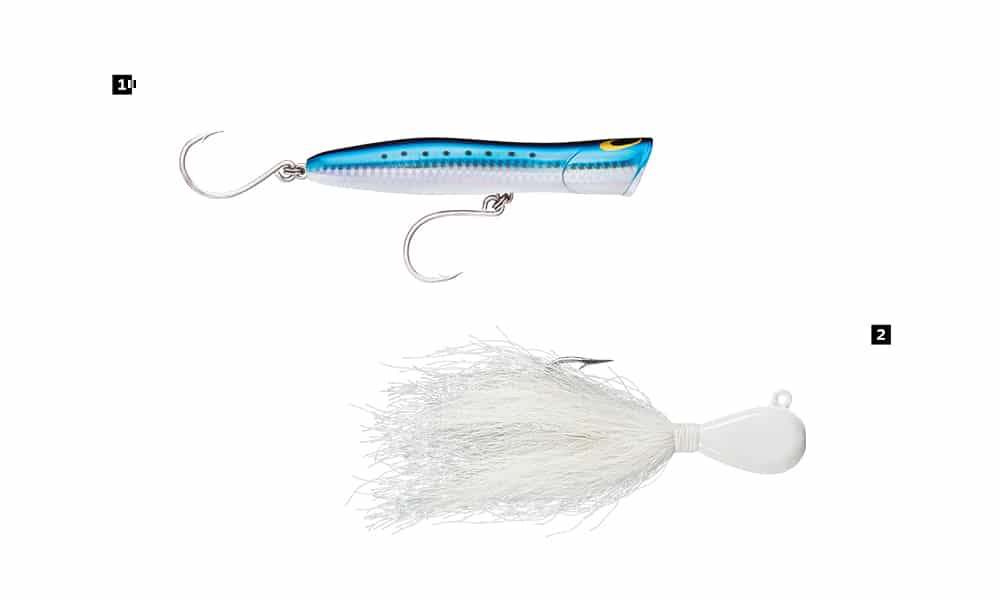
SWS Tackle Box: New England Buoy Hopping
Rod: Medium-heavy spinning
Reel: 6000 series
Line: 30-pound braid, 2 feet of 30-pound fluorocarbon leader
Hook: 4/0 J hook
Bait: Squid chunks
Lure: 6-inch RonZ jig
SWS Tackle Box: Mid-Atlantic Weed Lines
Rod: 30-pound-class trolling rod
Reel: 30-pound-class
Line/leader: 30-pound mono, 20 feet of 50-pound wind-on, 5 feet of 80-pound mono, 2-ounce egg sinker
Hook: 7/0 dink-bait hook
Bait: Small ballyhoo
SWS Tackle Box: Florida Run and Gun
Rod: Medium-heavy spinning
Reel: 6000 series
Line/leader: 30-pound braid, 5 feet of 50-pound fluorocarbon
Hook: 5/0 short-shank live-bait hook
Bait: Live pilchards
Lures: 1-ounce lima bean bucktail, topwater popping plug









